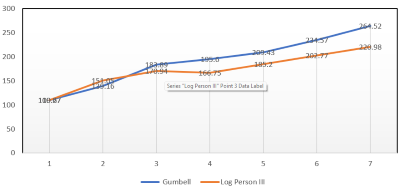Comparison of Gumbel Method and Log Pearson Method in Flood Control in Konto River Jombang
DOI:
https://doi.org/10.24036/cived.v11i3.645Keywords:
Gumbel Method, Log Person, Herlan PratiktoAbstract
This study aims to analyze the potential for flooding in the Konto River, Gudo District, Jombang Regency, this study uses the Gumbel and Log Pearson III statistical methods. Floods in this area often occur due to rainwater flow from the surrounding mountains which causes damage to infrastructure and settlements. Maximum daily rainfall data from 2013 to 2023 are used in this analysis. The Gumbel method is a statistical technique that is often used to analyze extreme rainfall data. The Gumbel and Log Pearson III methods are applied to estimate the design rainfall based on the flood return period, which is useful in infrastructure planning and flood mitigation. The calculation results show that the design rainfall increases with the increase in the return period. Compared to the Log Pearson III method, the Gumbel method provides higher design rainfall results, making it more suitable for estimating extreme rainfall in this area. These results are important in efforts to manage water resources and control flooding in the Konto River. The design rainfall will increase with the longer return period. This means that the higher the design rainfall, the smaller the possibility of it happening again. The results of the calculations show that the three methods can be used to calculate the planned rainfall, because the differences between one method and another are not much different, but the most suitable method to use is the gumbell method because the planned rainfall value is greater.
Downloads
References
I. P. Himari, “Analisis debit banjir rancangan untuk perencanaan bendung randangan,” Radial, vol. 2, no. 1, pp. 17–20, 2014.
F. A. Islami, Perencanaan pengendalian banjir menggunakan HEC-RAS, no. December. 2021. [Online]. Available: https://www.researchgate.net/publication/357048240%0APERENCANAAN
D. H. Santoso, “Penanggulangan Bencana Banjir Berdasarkan Tingkat Kerentanan dengan Metode Ecodrainage Pada Ekosistem Karst di Dukuh Tungu, Desa Girimulyo, Kecamatan Panggang, Kabupaten Gunungkidul, DIY,” J. Geogr., vol. 16, no. 1, pp. 7–15, 2019, doi: 10.15294/jg.v16i1.17136.
I. N. Sholi, R. R. R. Hadiani, and E. S. Suryandari, “Analisis Kapasitas Drainase Sebagai Upaya Pengendalian Banjir Di Kelurahan Sangkrah, Surakarta,” Matriks Tek. Sipil, vol. 8, no. 2, pp. 256–263, 2020, doi: 10.20961/mateksi.v8i2.44177.
M. Debby Rizani, M. Chamim Nufis, and M. Ridwan, “PENGENDALIAN BANJIR SUNGAI BANGER KOTA SEMARANG DENGAN ANALISA HEC-RAS Info Artikel,” Sist. Inf. J. Ilm. USM, vol. 18, no. 1, pp. 50–58, 2023, [Online]. Available: http://journals.usm.ac.id/index.php/teknika
W. Mundra, L. K. Wulandari, and S. Ahmadi, “Pengendalian Banjir Melalui Sumur Resapan,” Pros. SEMSINA, vol. 3, no. 1, pp. 24–27, 2022, doi: 10.36040/semsina.v3i1.4871.
A. S. Ningrum and K. B. Ginting, “Strategi Penanganan Banjir Berbasis Mitigasi Bencana Pada Kawasan Rawan Bencana Banjir di Daerah Aliran Sungai Seulalah Kota Langsa,” Geogr. Sci. Educ. J., vol. 1, no. 1, pp. 6–13, 2020, [Online]. Available: https://jurnal.unsil.ac.id/index.php/geosee/article/view/1919
D. P. Suadnya, J. S. F. Sumarauw, and T. Mananoma, “Analisis Debit Banjir Dan Tinggi Muka Air Banjir Sungai Sario Di Titik Kawasan Citraland,” J. Sipil Statik, vol. 5, no. 3, pp. 143–150, 2017, [Online]. Available: https://ejournal.unsrat.ac.id/index.php/jss/article/view/16237
M. M. N. Ramadani, “Analisa Debit Air Menggunakan Metode Log Person Type Iii Dan Metode Gumbel Berbasis Sistem Informasi Geografi ( Sig ) Di Sub DAS Martapura,” J. Univ. Islam Malang, no. 2110512049, pp. 165–175, 2018.
D. Ruhiat, “Implementasi Distribusi Peluang Gumbel Untuk Analisis Data Curah Hujan Rencana,” Teorema Teor. dan Ris. Mat., vol. 7, no. 1, p. 213, 2022, doi: 10.25157/teorema.v7i1.7137.

Downloads
Published
Issue
Section
License
Copyright (c) 2024 Moch. Danara I.P, Sony Susanto, Herlan Pratikto

This work is licensed under a Creative Commons Attribution 4.0 International License.

